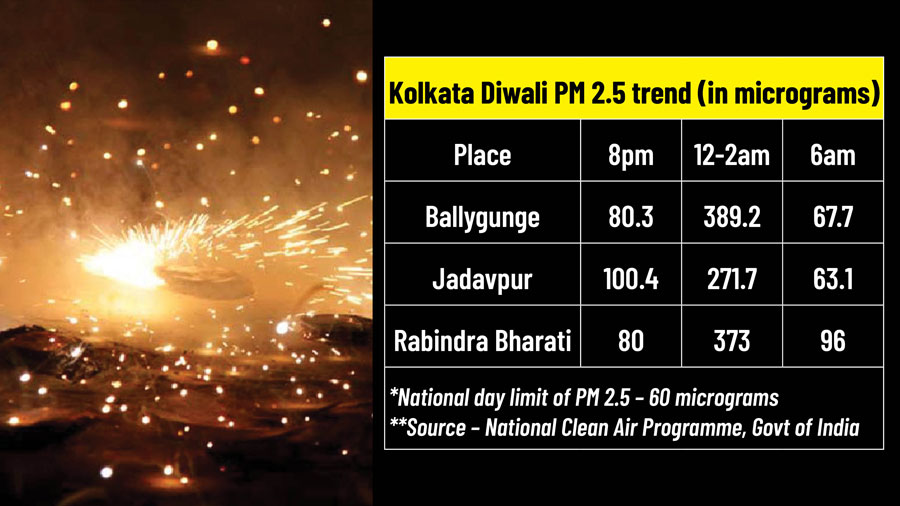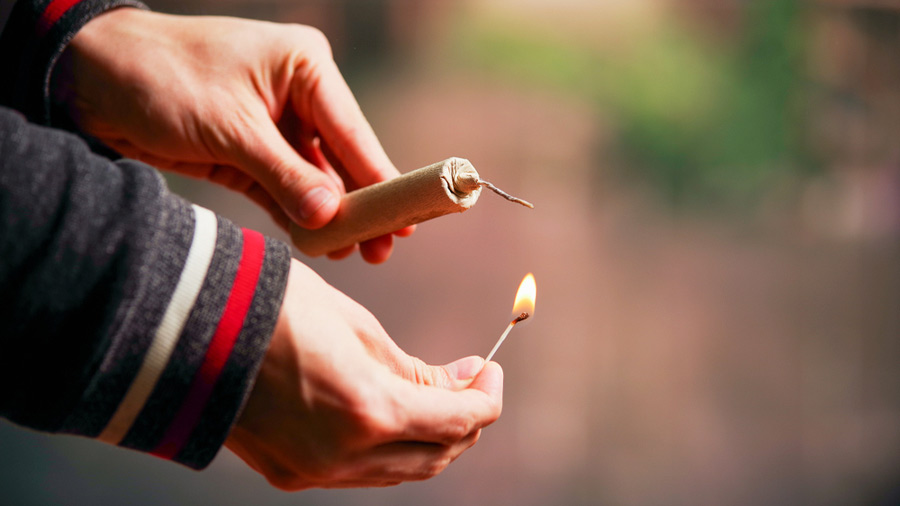The pollution impact of the latest Diwali, one of the worst in recent years, would have been far greater if the weather gods hadn’t lent a helping hand in quick dispersal of polluted air.
Wind blowing faster than usual at this time of the year turned out to be the saviour though doctors had warned of short-term exposure with serious impact on human lungs.
The data generated under the National Clean Air Programme (NCAP), set up by the Union ministry of environment, forest and climate, shows that ultrafine toxic air pollutant PM 2.5 that recorded a rapid surge in Kolkata on Diwali night took nearly 10 hours to return to the pre-cracker-bursting level. Without the meteorological factor, the turnaround time could have been 14 hours or more.
Sudden exposure to very high PM 2.5 concentration can trigger respiratory and other diseases among those already suffering and may also affect the healthy persons on prolonged exposure, experts said.
Midnight menace
The data analysed by environmental communication think-tank Climate Trends and accessed by The Plurals shows that Kolkata’s average of PM 2.5 was 82.8 micrograms per cubic metre at 8pm on Diwali night. The Supreme Court had only allowed green crackers to burst from 8pm to 10pm on Diwali night — a norm that was blatantly flouted across the city.
The PM 2.5 concentration in the city started to peak from 9pm — 152.3 micrograms — and reached 324 micrograms at midnight, surging further to 358 micrograms around 2am on Monday; and ultimately dropping back to 79 micrograms at 6am. The national day limit of PM 2.5 is 60 micrograms.
The PM 2.5 average close to midnight on November 11, the day before Diwali, was 156 micrograms; less than half of the Diwali midnight average; underlining the impact of cracker bursting on Diwali. PM 2.5 is the ultrafine particulate that can penetrate deep into the lungs and trigger a range of diseases, some of them fatal.
The peak period on Diwali night varied at Kolkata’s seven automatic monitoring stations but was highest between midnight on Diwali and 2am on Monday everywhere.
Ballygunge, one of the worst-hit residential areas, recorded 80.3 micrograms of PM 2.5 at 8pm, rising to 389.2 micrograms between midnight and 2am before stabilising at 67.7 micrograms at 6am. The PM 2.5 level at Jadavpur, another south Kolkata neighbourhood, rose to 271.7 micrograms around midnight from 100.4 at 8pm, before settling at 63.1 micrograms around 6am on Monday.
The area around Rabindra Bharati University in north Kolkata saw a jump from 51.8 micrograms of PM 2.5 concentrations at 8pm on Diwali evening to 223.3 micrograms at midnight and back to 54.7 micrograms at 6am.
High exposure affects all
“On previous Diwali nights, especially when the festival fell in November, it took much longer for the PM 2.5 concentration to return to normal. Generally, the air would remain polluted till at least 10am the next day. But a combination of several meteorological parameters worked in tandem to ensure that normalcy was achieved earlier this year,” said Abhijit Chatterjee, an air pollution scientist from Bose Institute; also associated with NCAP as an expert.
“Firstly, the wind speed during morning hours, 6am onwards, of the day after last Diwali was 0.1 meter per second higher than the Diwali evening and night, unlike last year, which could be the reason that particulate matter pollutants that were trapped during Diwali night got a chance to easily disperse from early morning hours, and the pollution level got reduced this year quicker than earlier years,” Chatterjee said.
Arup Haldar, a pulmonologist associated with a city hospital, warned: “Short-term sharp pollution surge can have long-term impact on those exposed, especially those already affected.
“Such a spurt can lead to hospitalisation among those already suffering from respiratory diseases,” said Anumita Roy Chowdhury, an air pollution expert from environment think-tank Centre for Science and Environment (CSE)


